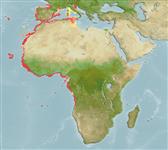Environment: milieu / climate zone / depth range / distribution range
Ecologie
marien demersaal; diepte 1 - 300 m (Ref. 27000), usually 4 - 160 m (Ref. 95541). Subtropical; 47°N - 13°S, 27°W - 42°E
Eastern Atlantic and Mediterranean Sea. Records of Epinephelus alexandrinus from Madeira are apparently based on misidentifications of Myctoperca fusca.
Lengte bij maturiteit / Grootte / Gewicht / Leeftijd
Maturity: Lm 32.5, range 30 - 35 cm
Max length : 140 cm SL mannelijk / geslacht onbekend; (Ref. 12382)
Dorsale stekels (totaal) : 11; Dorsale zachte stralen (totaal) : 15 - 17; Anale stekels: 3; Anale zachte stralen: 8. Distinguished by the following characteristics: head and body brownish, fins darker; two dark lines on head, one from lower edge of the eye to the ventral rear edge of the interopercle, 2nd from the dark maxillary streak to the lower edge of the preopercle; adults brown or greyish brown; distinct yellow blotch on body below the spinous dorsal fin; body depth less than head length, depth contained 3.0-3.4 times in Sl; head length 2.5-2.7 times in SL; interorbital area convex; angular preopercle, 2-3 enlarged serrae at the angle; middle and lower opercular spines flat but distinct, upper spine not apparent; straight or slightly convex upper edge of operculum; maxilla usually reaching a vertical rear edge of eye, ventral edge of maxilla with low step, no scale on maxilla; 2 rows of teeth on midlateral part of lower jaw; lateral body scales ctenoid, with auxilliary scales in adults; pyloric caeca 17 (Ref. 89707).
Found on sand, mud or rock bottoms (Ref. 6789). Juveniles form small groups (Ref. 12382) in shallow water (Ref. 89707). Feeds on crustaceans, mollusks, and fish (Ref. 12382). Does not adapt well in aquariums (Ref. 12382). Maximum depth from Ref. 128827.
Levenscyclus en paargedrag
Maturiteit | Voortplanting | Paaien | Eieren | Fecunditeit | Larven
Heemstra, P.C. and J.E. Randall, 1993. FAO Species Catalogue. Vol. 16. Groupers of the world (family Serranidae, subfamily Epinephelinae). An annotated and illustrated catalogue of the grouper, rockcod, hind, coral grouper and lyretail species known to date. Rome: FAO. FAO Fish. Synop. 125(16):382 p. (Ref. 5222)
Status op de Rode Lijst van het IUCN (Ref. 130435: Version 2024-2)
Gevaar voor de mens
Harmless
Gebruik door de mens
Visserij: van minder commercieel belang
Tools
Speciale rapporten
Download XML
Internetbronnen
Estimates based on models
Preferred temperature (Ref.
123201): 13.4 - 27.5, mean 19 °C (based on 650 cells).
Fylogenetische diversiteitsindex (Ref.
82804): PD
50 = 0.5000 [Uniqueness, from 0.5 = low to 2.0 = high].
Bayesian length-weight: a=0.00832 (0.00502 - 0.01379), b=3.01 (2.87 - 3.15), in cm total length, based on LWR estimates for this species & Genus-body shape (Ref.
93245).
Trofisch niveau (Ref.
69278): 3.9 ±0.61 se; based on food items.
Generation time: 9.2 ( na - na) years. Estimated as median ln(3)/K based on 2
growth studies.
Weerstandsvermogen (Ref.
120179): Gemiddeld, minimale populatieverdubbelingstijd 1,4-4,4 jaar (tm=4).
Fishing Vulnerability (Ref.
59153): High to very high vulnerability (66 of 100).
Nutrients (Ref.
124155): Calcium = 29.4 [12.3, 68.2] mg/100g; Iron = 0.754 [0.358, 1.747] mg/100g; Protein = 18.6 [16.9, 20.1] %; Omega3 = 0.283 [0.154, 0.524] g/100g; Selenium = 41.6 [19.3, 100.7] μg/100g; VitaminA = 17.3 [4.1, 73.8] μg/100g; Zinc = 0.665 [0.425, 1.080] mg/100g (wet weight);
